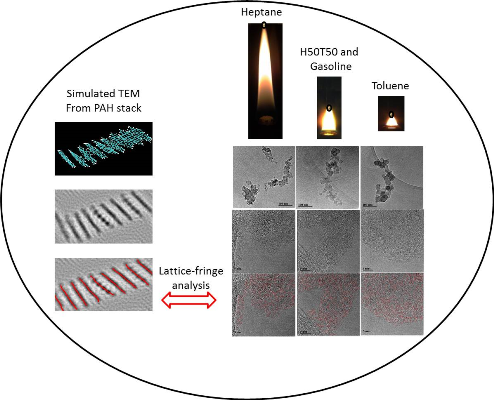Technical Report 155, c4e-Preprint Series, Cambridge
HRTEM study of soot particles produced by the non-premixed combustion of liquid fuels
Reference: Technical Report 155, c4e-Preprint Series, Cambridge, 2015
- Simulated TEM images were artificially generated from stacks of polycyclic aromatic hydrocarbons.
- An image analysis algorithm was developed to calculate the fringe length, tortuosity and inter-fringe spacing from HRTEM images.
- Toluene exhibits the largest degree of graphitisation. Heptane develops a similar degree of order as the aromatic flames but presents stronger soot oxidation at the tip.
- The main differences in the nanostructure of the soot sampled from different flames was the arrangement and degree of order of the PAHs within each particle.
 In this paper the morphology and nanostructure of soot particles as a function of fuel type in a laminar diffusion flame were studied. The fuels considered were heptane, toluene, the volumetric mixture 50% heptane - 50% toluene and a commercial gasoline. The structural features of soot sampled at different positions in the flame were inferred using HRTEM. An image analysis algorithm was developed to calculate the fringe length, tortuosity and inter-fringe spacing from HRTEM images. To assess the performance of the algorithm, simulated TEM images were artificially generated from stacks of polycyclic aromatic hydrocarbons (PAHs). The fringe analysis was performed on the simulated TEM. A good agreement between the fringe image analysis and the known sizes of the molecules and their separation. Primary particles as small as 6 nm were detected in the inception region of the heptane flame, growing to sizes as large as 60 nm in all the flames. Strong oxidation was observed close to the tip in all the flames, affecting mainly the fringe length and, to a lesser extent, the curvature and inter-fringe spacing. Overall, temperature and fuel aromaticity were found to have a great influence in the nanostructure of soot. Toluene exhibits the largest degree of graphitisation. Heptane develops a similar degree of order as the aromatic flames but presents stronger soot oxidation at the tip that reduces the fringe length and increases the highly tortuous fringes. The main differences in the nanostructure of the soot sampled from different flames was the arrangement and degree of order of the PAHs within each particle.
In this paper the morphology and nanostructure of soot particles as a function of fuel type in a laminar diffusion flame were studied. The fuels considered were heptane, toluene, the volumetric mixture 50% heptane - 50% toluene and a commercial gasoline. The structural features of soot sampled at different positions in the flame were inferred using HRTEM. An image analysis algorithm was developed to calculate the fringe length, tortuosity and inter-fringe spacing from HRTEM images. To assess the performance of the algorithm, simulated TEM images were artificially generated from stacks of polycyclic aromatic hydrocarbons (PAHs). The fringe analysis was performed on the simulated TEM. A good agreement between the fringe image analysis and the known sizes of the molecules and their separation. Primary particles as small as 6 nm were detected in the inception region of the heptane flame, growing to sizes as large as 60 nm in all the flames. Strong oxidation was observed close to the tip in all the flames, affecting mainly the fringe length and, to a lesser extent, the curvature and inter-fringe spacing. Overall, temperature and fuel aromaticity were found to have a great influence in the nanostructure of soot. Toluene exhibits the largest degree of graphitisation. Heptane develops a similar degree of order as the aromatic flames but presents stronger soot oxidation at the tip that reduces the fringe length and increases the highly tortuous fringes. The main differences in the nanostructure of the soot sampled from different flames was the arrangement and degree of order of the PAHs within each particle.
Material from this preprint has been published in Carbon.
PDF (19.9 MB)



